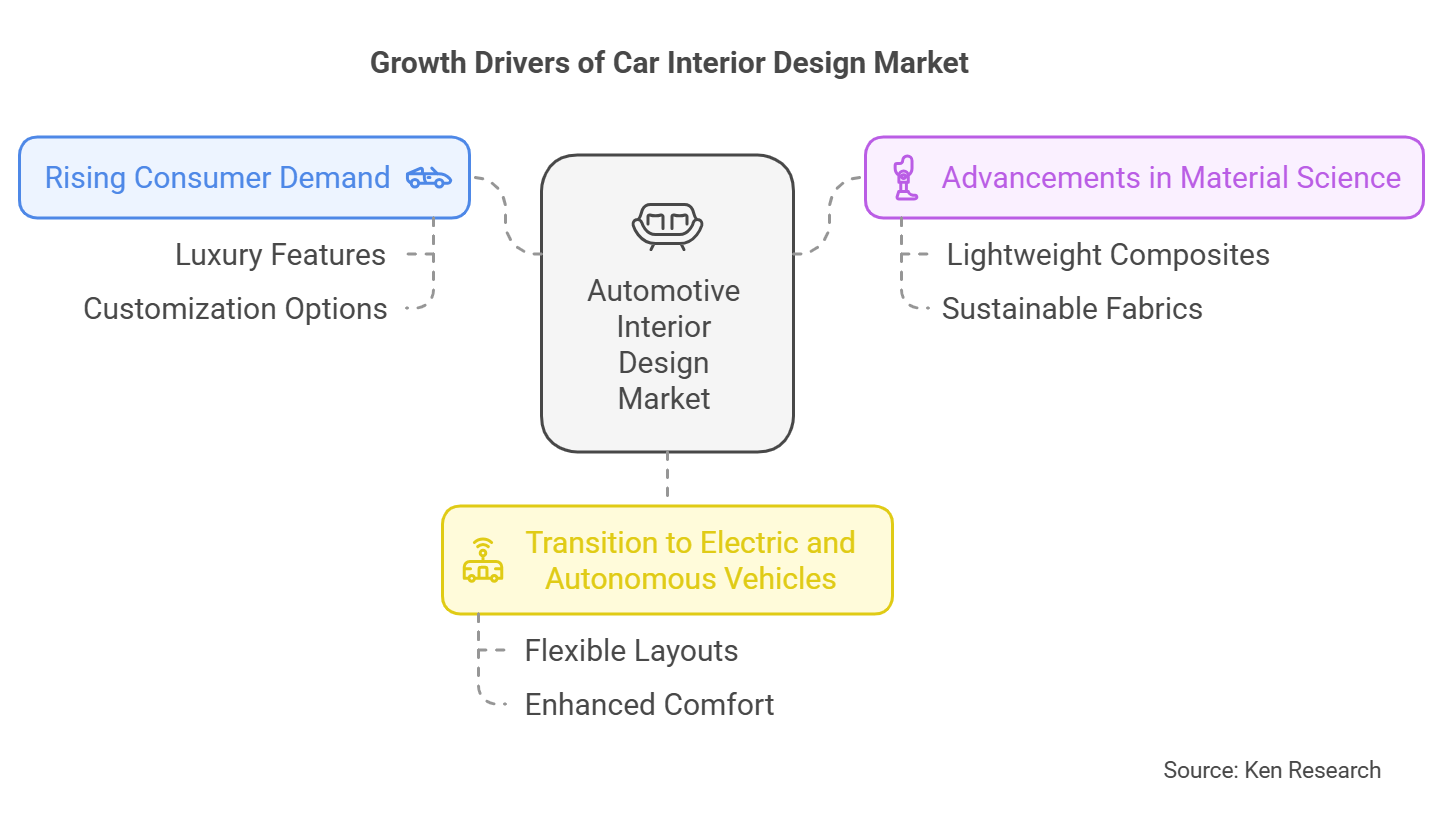Global Automotive Interior Design Market Trends, Innovations, and Future Outlook

Key Drivers of the Global Automotive Interior Design Market
1. Rising Consumer Demand for Luxury Features
Consumers are willing to invest more in vehicles with high-end interior features, including premium seating, customizable ambient lighting, and advanced infotainment systems. This trend is particularly prominent in the luxury vehicle segment, where interior design serves as a key differentiator.
- Market Insight: A 2023 survey revealed that 70% of consumers would pay a premium for vehicles offering enhanced interior features such as smart surfaces and immersive infotainment systems.
2. Advancements in Material Science
The development of lightweight composites, sustainable fabrics, and advanced polymers is revolutionizing automotive interiors by offering improved durability, aesthetics, and comfort. These materials not only enhance interior design but also contribute to fuel efficiency and reduced emissions.
- Industry Statistics: A 10% reduction in vehicle weight can lead to a 5-7% improvement in fuel efficiency, highlighting the dual benefits of innovative materials.
3. Transition to Electric and Autonomous Vehicles
The rise of electric vehicles (EVs) and autonomous driving technologies is reshaping interior design priorities. With more interior space available due to the absence of traditional powertrains, automakers are adopting flexible layouts that enhance passenger comfort and functionality.
- Future Projection: By 2030, 15% of vehicles are expected to be autonomous, creating demand for interiors tailored to relaxation, entertainment, and productivity.
Market Segmentation
By Component Type: Seats Lead the Market
- Seats accounted for the largest share in 2023, driven by the demand for ergonomic designs and customizable comfort features.
- Infotainment systems are also growing rapidly, reflecting consumer preferences for connected vehicle experiences.
By Vehicle Type: Passenger Cars Dominate
- Passenger cars held the largest market share in 2023, with the growing adoption of luxury and premium vehicles driving this segment.
- The rise of the luxury electric vehicle market has further boosted the focus on innovative interior designs.
By Region: North America Leads
- North America dominated the market in 2023, supported by high R&D investments, strong demand for luxury vehicles, and the presence of leading automakers.
- Asia-Pacific is an emerging market, driven by the growing EV sector in China and India and rising consumer spending on premium vehicles.
Competitive Landscape
Key players in the global automotive interior design market include:
- Faurecia: Introduced the “Cockpit of the Future” concept in 2023, featuring smart surfaces, personalized ambient lighting, and modular seating solutions.
- Lear Corporation: Unveiled a range of eco-friendly fabrics with up to 50% recycled content, aligning with sustainability goals.
- Adient: Focuses on developing advanced seating systems that prioritize comfort and safety.
- Continental AG: Pioneers in AI-integrated infotainment systems and connected vehicle solutions.
- Magna International: Specializes in modular interiors with a focus on sustainability and user-centric design.
Growth Challenges
1. High Costs of Advanced Interior Features
While premium interior components enhance user experience, their production costs remain high. For instance:
- Electronic components now account for 8-12% of a vehicle’s total cost, up from 1-2% in the past.
2. Technical Complexity
Integrating new technologies like AI-driven infotainment systems and adaptive lighting requires advanced expertise, leading to longer development cycles and higher costs.
Government Initiatives Supporting Market Growth
- European Union’s Green Deal:
- Targets net-zero greenhouse gas emissions by 2050.
- Promotes the use of sustainable materials in automotive manufacturing.
- California’s Clean Air Act:
- Mandates that 35% of new car sales be zero-emission vehicles (ZEVs) by 2026, increasing to 100% by 2035.
- Encourages the use of sustainable interior materials in electric vehicles.
Future Market Trends
1. Integration with Autonomous Systems
- By 2028, interiors will be designed to support autonomous driving, focusing on versatile layouts for work, relaxation, and entertainment.
2. Sustainability in Interior Design
- The adoption of recycled and eco-friendly materials will grow, with manufacturers focusing on reducing vehicle weight and aligning with global environmental goals.
3. Rise of Smart Interiors
- AI-driven infotainment systems, voice-controlled features, and connected ecosystems will become standard in premium and mid-range vehicles.
Conclusion
The Global Automotive Interior Design Market is evolving rapidly, driven by consumer demand for luxury, technological advancements, and the transition to electric and autonomous vehicles. Companies like Faurecia, Lear Corporation, and Adient are leading the way with innovative solutions that prioritize comfort, sustainability, and connectivity.
Despite challenges like high production costs and technical complexity, the market’s future is promising. By 2028, trends such as smart interiors, sustainable materials, and autonomous-ready designs are expected to dominate, transforming the role of interiors in enhancing the overall driving experience.







